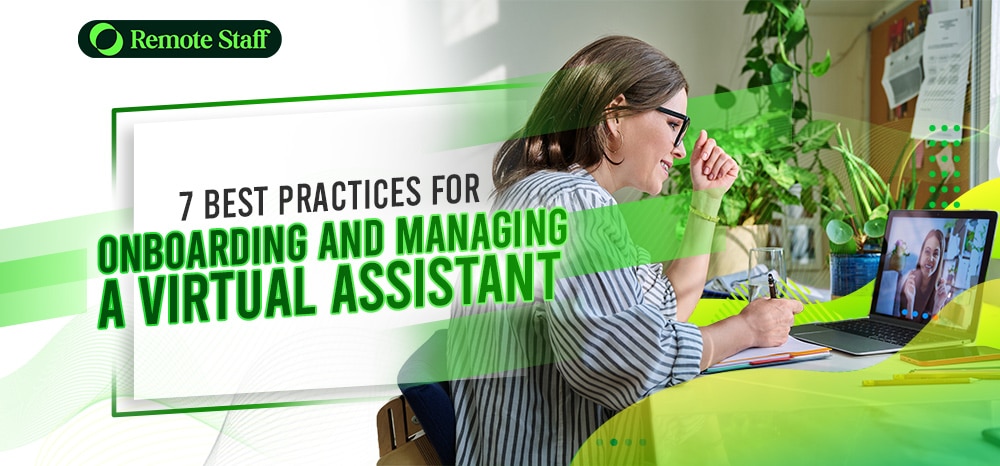Are you and your team constantly swamped with routine administrative tasks lately? Do you spend most of your time writing emails, planning meetings, or organizing files – when there’s so much more you could do to grow your business?
If so, what you need is a virtual assistant (VA).
Hiring a skilled virtual assistant boosts your team’s productivity by handling most repetitive tasks, enabling you to put more effort into things that only you can do.
That said, to optimize your virtual assistant’s performance, you must also take time to properly onboard them. Doing so helps them acclimate to your company better and understand their role.
Onboarding a remote employee can be challenging without the face-to-face interactions, but worry not, we’re here to help.
Here are some tips on how you can best onboard and manage your new virtual assistant:
Set Up Their IT Access
Before your virtual assistant can start working, they’ll need access to your company’s technology tools and systems. These include:
- An email account on your company’s domain, alongside an email signature signifying they’re your VA,
- Access to your company’s chosen calendar platform/apps and task management platform (Trello, ClickUp, Monday.com, etc.), and
- An account with your chosen online communication app (Skype, Zoom, Google Chat, Slack, Microsoft Teams, etc.).
If your VA needs access to your e-commerce accounts, use password encryption tools like BitLocker or LastPass.
In addition to these, some VAs may require assistance with procuring personal computers/laptops capable of handling their tasks.
Provide Documentation and Training Materials
Since no two businesses are alike, you should still take time to train your VA even if they have prior experience.

They should receive comprehensive documentation and training materials on your company’s processes, tools, and systems.
These include creating detailed manuals, video tutorials, and step-by-step guides about their essential tasks and procedures.
Doing so helps them quickly familiarize themselves with their tasks without constantly asking you for clarification.
Establish Clear Communication Channels
One of the main challenges of working with a virtual assistant is effectively communicating with them.
Aside from the lack of in-person interactions, your VA could be working in a different time zone as well.
Thus, as soon as you start onboarding your VA, you should set standards on how you two communicate.

This means scheduling regular check-ins to discuss their progress, resolve any issues they face, and provide feedback.
Set Expectations
Before your VA starts working, set your expectations straight.
This helps them understand their role within the company, which tasks they must prioritize, and how their success will be measured.
Aside from these, you should also discuss the following with your new VA:
- Your expected work hours and days,
- How quickly you expect them to respond to your emails, messages, and video call requests,
- Deadlines on immediate projects and the quality of work you expect from them,
- Confidentiality standards when handling sensitive information,
- How you expect them to communicate with you, your team, and your clients.
Regularly Provide Feedback
Receiving appropriate feedback helps your VA improve and can help shorten their learning curve.
Providing constructive feedback to your VA also boosts their confidence and motivates them to maintain or improve their performance further.

Introduce Them to the Rest of the Team
Meeting one’s co-workers is just as important in a remote setup as in the office.
After briefing your new VA, it’s time for them to meet your team so they can get acquainted and establish rapport for a positive working relationship.
Start With Assigning a Simple Task
Assigning all your time-consuming administrative tasks immediately can overwhelm them, leading to quick burnout.
Instead, start with a simple task like managing one meeting request or drafting a simple email. This can build their confidence and give them a better understanding of your workflow.
Once they’ve become familiar with these tasks, you can move on to more complex ones like managing your calendar or conducting market research.
Ready to Get to Work?
Successfully onboarding an employee can make all the difference between a lasting and productive working relationship -and having to look for a new one after six months.
So if it’s your first time hiring a virtual assistant, onboard them properly with the tips above.
Are you still looking for the right VA for your company’s needs? Click here to see our list of candidates for this and other roles like admin assistants, virtual receptionists, and virtual personal assistants.
John Carlo Pagsolingan is a carefree yet hardworking writer with aspirations of becoming a teacher in the future. He believes that remote working isn’t just a substitute; but is a legitimate alternative to face-to-face work. Learn more as he writes about the advantages of remote work and tips for aspiring remote workers.






